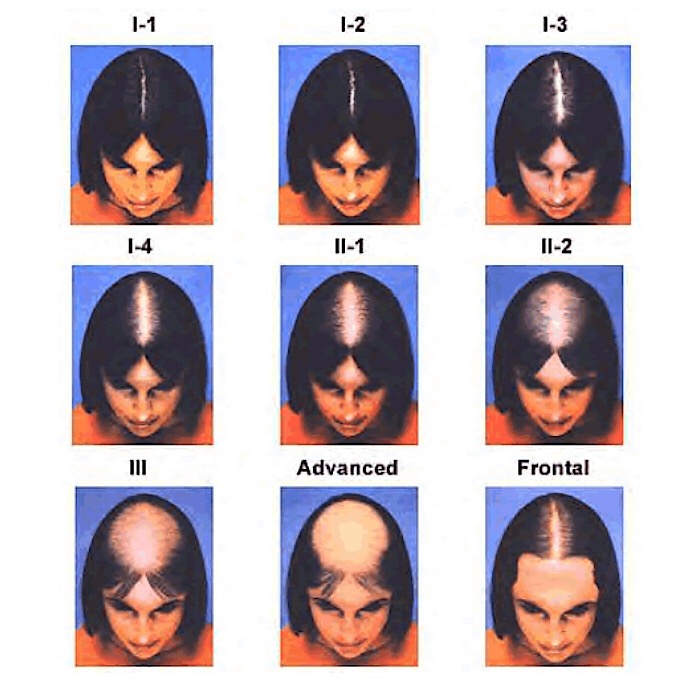Menopause, the time in a woman’s life that marks the end of her menses, can usher in many positive physical and psychological changes such as a recommitment to self-care, a healthy diet, and exercise goals. Unfortunately, for many of us, hair loss can also be part of the package. Just when we’re bestowed our silver crowns, nature decides to rip them away one precious glittery strand at a time. While there are many types of hair loss, the two that dominate during the time of “the change” are Female Pattern Hair Loss (FPHL”>, which is also known as Androgenic Alopecia, and Telogen Effluvium. While each of these conditions has a different cause (or causes”>, they can exist concurrently, making the hair loss difficult to resolve. That is the bad news. The good news is that the same well-earned skills that we have gained about our curls and scalp health by transitioning can help. We are far more aware of products, ingredients, and healthy-hair practices than many of our non-curly peers. If you are currently experiencing post-menopausal hair loss, now is the time to put your wisdom to work.
What is Female Pattern Hair Loss?
The type of hair loss and thinning that you will see with FPHL starts as a widening part, and then very gradually progresses to diffuse thinning that covers the top of head and spreads to the crown. For women, the severity of hair loss is measured using the Savin scale (shown below”>, or the Ludwig scale.

Image Source: WebMD
When experiencing FPHL, a portion of hairs on this area of your scalp shed and are replaced by thinner and shorter hairs during each growth cycle, or anagen phase. This continues through each subsequent cycle of hair loss and regrowth until vellus hairs which are extremely fine, weak, and colorless develop. This is called follicle miniaturization. It is an indication of impending follicle death.
What Causes Female Pattern Hair Loss?
There are two causes of female pattern hair loss: androgens and heredity. Our hair follicles contain androgen receptors which are highly receptive to androgen hormones. When they are present, the genes that shorten the hair growth cycle are activated. Unlike men with male pattern thinning who have high levels of free testosterone circulating in their blood, women with FPHL have high levels of 5α-reductase the enzyme responsible for converting our normal levels of testosterone to dihydrotestosterone. We also have more androgen receptors, and low levels of cytochrome P450, a family of enzymes that converts testosterone to estrogen.
Several genes have been implicated in FPHL. If your mom, or grandma, or other close family members have been diagnosed with FPHL, and you are losing your hair in a similar manner, chances are you have inherited the genes responsible for this type of hair loss. As of this date, there is no reliable test to determine your genetic predisposition to this condition. It is best to compare your hair loss to the Savin scale image above.
What is Telogen Effluvium?
Telogen refers to the resting stage in the hairs’ growth cycle. In Telogen Effluvium (TE”> up to 70% of hairs are pushed into this resting stage, many of them prematurely. This will cause dramatic excessive shedding all over the scalp. The condition can be acute or chronic.
Acute TE is when one episode happens, and then spontaneously resolves without intervention. Chronic TE can fluctuate for several months to several years. You can also have one attack of TE, and then a second attack before the first one is resolved. In order to diagnose TE, a lab or your healthcare provider will look at the shed hairs under a microscope. They will have clubbed ends. You may also be able to view the hair with an app such as Cozy Magnifier and Microscope. Another way to identify this type of hair loss is with a punch biopsy, where your Dr. sends a section of skin and underlying tissue to a lab for analysis.
What Causes Telogen Effluvium?
Acute cases of TE in post-menopausal women tend to be the result of an emotional or physical traumatic incident which can include:
- Surgery.
- Severe infection.
- Loss of a loved one.
- Divorce or major life change.
- Certain medications. (Note that TE can become chronic if the hair loss side effect of the medication is not a temporary one. In cases of Anagen Effluvium, hair loss due to chemotherapy drugs, hair loss will resolve on its own when the chemo sessions are over.”>
Chronic cases of TE tend to be more complex and can involve more than one trigger which can include:
- Having undergone a gastric bypass.
- Ferritin levels under 50. Ferritin levels are the amount of stored iron in your body. You can read more about them here.
- Too much Vitamin A.
- And overactive or underactive thyroid gland (referred to as hyper or hypothyroid”>.
- Lead and/or Cadmium toxicity.
- Poor circulation to scalp (in cases of crown thinning”>.
- Inadequate Zinc intake.
Who Should You Talk to About Your Hair Loss?

Image Source: Getty Images
There are three types of professionals whose help you might enlist if you have hair loss. Your first choice should be your Primary Care Physician (PCP”>, particularly if you are having other health-related symptoms such as excessive fatigue (which can indicate low Ferritin levels”>, or extreme difficulty losing weight (indicative of Hypothyroidism”>. This is important for two reasons: 1. Any underlying health conditions must be addressed in order to stop the TE from progressing, and 2. A Dermatologist would likely use different diagnosis codes for lab work than a PCP would if a health condition is suspected, and certain tests submitted by a Dermatologist may not be covered by insurance if hair loss (also referred to as non-scarring Alopecia”> codes are used.
After seeing your Primary Care Physician, a Dermatologist who specializes in hair loss can be very helpful, particularly if you are having other scalp issues such as flaking or scaling, redness, irritation or cysts. He or she can also help advise you on product sensitivities, and scalp care.
If, after seeing these two professionals you have been unable to resolve your hair loss issues, a Trichologist visit is in order. A Trichologist has the tools and training to get to the root (literally”> of your hair issues and can help you optimize your scalp health in order to regrow lost hair. Here is a video showing the types of treatments a Trichologist does:
Embedded content: https://www.youtube.com/watch?v=0sWktKL8TIQ&t=432s
How Should You Prepare for Your Doctor Visit(s”>?
There are four things that you should do before you talk to Doctors:
- If you are having any other health-related concerns and symptoms besides hair loss, type them out and have a printout ready for the Doctor to review. Some offices have a “no cell phones” rule.
- Prepare a list of your current medications and supplements along with their dosages.
- Educate yourself fully on hair loss so that you can ensure that you can ensure you are getting all the help you need. The following video is a comprehensive look at hair loss:
Embedded content: https://www.youtube.com/watch?v=giBALq34cKs
Hair Loss: Myths and Realities | Carolyn Goh, MD – UCLA Health
- Understand the lab tests that may be ordered to diagnose your hair loss cause (s”>. Tell your Doctor that you want to make a follow-up appointment to discuss them, and that you will want to know your exact numbers, and if they are within the optimal ranges for hair regrowth. This is because the normal range for some tests can be less than optimal for hair growth. For example, the normal range for Ferritin levels is 12 to 150 ng/mL for women, yet, hair loss can occur at levels under 50 ng/mL. Common lab tests for hair loss may include but are not limited to the following:
- DHEA (dehydroepiandrosterone”>. Low levels of this androgen hormone have been implicated in FPHL. Other hormone lab tests may be ordered as well.
- Serum iron, serum ferritin, and total iron binding capacity (TIBC”>. Primarily, you will want to know your Ferritin levels.
- Thyroid panel (T3, T4, TSH”>. This test is an indicator of thyroid health or imbalance.
- Complete blood count (CBC”>. A CBC can indicate the presence of infections or chronic illnesses. Further investigation may be required depending on the results.
- Cortisol levels (optional”>: This test may be warranted if you are experiencing chronic physical or mental stress.
- NutrEval (optional”>: This comprehensive nutritional evaluation may be ordered if a nutritional deficiency or toxicity is suspected.
Telogen Effluvium Treatments
In cases of acute Telogen Effluvium where no underlying disease exists, the hair loss will spontaneously resolve itself without any intervention. It will take 6-8 months for regrowth to appear. In chronic TE, the treatment will correspond to the underlying problem. It may include one or more of the following:
- Iron supplements to increase Ferritin levels. Iron bisglycinate, also known as chelated iron has the least potent for gastrointestinal side effects. Please do not take more than your Doctor’s recommended amounts because too much iron in the blood can cause health issues.
- Hyper or hypothyroid medications to treat thyroid imbalances.
- Antibiotics if an infection is present.
- Treatment of an underlying disease.
- Adjustment to current medications or their dosing schedules.
- Correction of any nutritional deficiencies with diet or supplementation.
Female Pattern Hair Loss Treatments

Image Source: Getty Images
Treatment of FPHL centers around three objectives:
- Correct any underlying hormonal imbalances.
- Prevent any further hair loss, and ideally, regrow a large percentage of lost hair.
- Optimize scalp health
Correct hormone imbalances:
In a small subset of post-menopausal women, a combination of Spironolactone and Finasteride can aid in reversing FPHL. However, these drugs come with unwanted side effects.
Prevent any further hair loss, and ideally, regrow a large percentage of lost hair.
- The topical medication Minoxidil (brand name Rogaine”> is the only topical medication approved by the FDA for the treatment of pattern hair loss in men and women. It comes in two strengths: 2% and 5%. Doctors recommend twice-daily application of the 2% strength or once-daily application of the 5% strength.
- Both the men’s and women’s formulas contain the same active ingredients. The generic Minoxidil and its brand name product Rogaine also contain the same ingredients. Most of the 2% formulations contain drying alcohol and are best avoided for curly hair. The 5% foam can cause side effects like a rapid heartbeat. An alternative is DrFormulas® HairOmega® Foam 2% Minoxidil.
- If you want to avoid disturbing your curl clumps or protective styles when applying Minoxidil, use a bayalage kit. Spray the desired amount of foam onto the board, and then use the brush to paint the foam onto the skin. You can then massage it in.
- You will begin to see new hair growth at about six months. The following hair loss and recovery story will show you will give you an idea of the length of time that Minoxidil will take to work: Does Rogaine/Minoxidil work on Black hair? 2 years later / TV Blake Review
- While Minoxidil is considered a relatively safe medication for hair loss sufferers who are not allergic to it, some of you may want more natural alternatives. Rosemary essential oil in combination with a carrier oil such as olive, coconut or jojoba at 25% Rosemary essential oil to 75% carrier oil is a good choice. Massage a few drops of this mixture into the thinning areas of your scalp two times per day.
- For balding at the temples, you may also want to incorporate a light massage of the temples with a Jamaican Black Castor Oil blend three times per week.
- To optimize the effectiveness of these topicals, use a Derma Roller. Click here for more on how to select and use one.
Optimize scalp health:
A critical component of scalp health is going to be keeping your scalp clean and free of product buildup, excess sebum, and debris. All of these can block hair follicles and prevent hair from growing. Some great shampoos for this purpose include:
- Uncle Funky’s Daughter Squeaky Deep Cleansing Shampoo
- Girl+Hair Clarifying Apple Cider Vinegar Rinse
- DevaCurl Buildup Buster Micellar Water Cleansing Serum
Most dermatologists and trichologists will recommend that curlies wash their hair more frequently, sometimes up to several times a week. This can be too harsh for delicate curls. In order to prevent dryness, you can try using the Condition-Wash-Condition Method.
Another component of optimizing scalp health is to increase circulation to it. One easy way to do this is through exercise. Cardio, dance, power yoga, brisk walks or anything that gets your blood flowing is a good bet. Exercise is also good for improving your overall health and decreasing your stress levels which in turn can improve your hair health.
How to Avoid Hair Loss Scams

Image Source: Getty Images
Lastly, as you can see from the above, there is no easy overnight fix to hair loss. It can take six months or more to resolve with the correct diagnosis, and even then the resolution might mean a lack of further progression, but not restoration. There are many supplements, devices, topicals, and shampoos that simply do live up to the claims on their labels. Some of them promise to fix the problem in a short amount of time, while others tell you it will take months. You can use the product for ages with no results, and during that time have additional hair loss which is then harder to resolve. It is best to follow the traditional route by getting a proper diagnosis, using FDA-approved treatments, and supplementing your efforts with good scalp care. Once this is working for you, you can always switch over to something else, and if your hair does not shed the product is effective.
To avoid wasting time, money or both, follow these tips:
- Do not purchase any product or product line that does not fully reveal its formula. This could be a product that touts its key ingredients and neglects to admit that they are in a base of denatured alcohol or propylene glycol (a common allergen”> is a key ingredient. A dry, inflamed, irritated scalp is not going to produce hair. Companies avoid full disclosure by stating their formulation is proprietary or patented. Don’t fall for that. I did, and I am here to tell the tale $200 dollars later.
- If you are deciding on purchasing a product or device, you can use fakespot to help. You can put in the product URL, and it will analyze the reviews and give a grade based on whether or not they are legitimate.
- Be wary of sponsored posts and videos. While many influencers will not review products that do not do what they claim, there are some that will.
- Exercise caution when purchasing any type of hair loss device, such as a laser cap. Due your due diligence by reading and researching the validity of reviews. Also check eBay. If you find a lot of used models of the product you intend to buy on there, there is a good chance it doesn’t work.
- Disregard product claims for topicals and shampoos. As you would with curly hair products, always read labels to ensure the products are free of allergens and ingredients that would damage your curls.
What are your favorite hair loss tips? Share them with your Naturally Curly community. Read more about hair loss and your hormones here.
